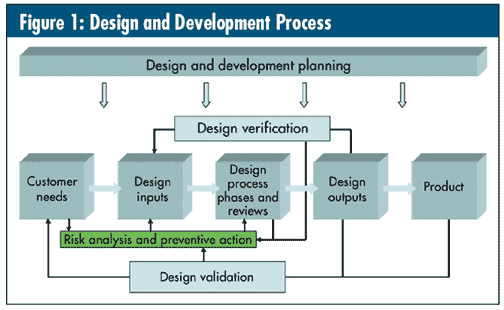Take Advantage of Subclause 7.3
During the late 1980s and into the 1990s, users of ISO quality management system (QMS) standards often defaulted to the old ISO 9002 so that they wouldn't have to deal with ISO 9001's requirements relating to control of product design. Even today, organizations new to the standard have a tendency to resist including design controls in their formal QMS. There are some good reasons for this reluctance.
There is, of course, a concern that applying the formal design review, verification and validation requirements of ISO 9001 subclause 7.3 might cause development efforts to be overly controlled, which could generate unwarranted costs. There's also a concern about "folks looking over the designer's shoulder." Perhaps most important, there may be a reluctance to invest the extra time necessary to analyze and understand the benefits of good design controls as a means of managing risk. In other words, for designers, the potential negatives of exercising controls tend to outweigh potential benefits.
On the other hand, most recognize that many manufacturing and service delivery problems have their roots in the design and development processes. So do many problems that relate to the marketplace failing to accept new products. Perhaps the key is to implement subclause 7.3 on design and development in a manner that will contribute to designers' creativity, reduce costs and ensure that customers' needs are met.
One approach is to ensure that a clear understanding exists of the requirements for design control and how they relate to issues such as achieving the organization's design goals, maintaining creativity and meeting cost objectives. Start by explaining the required controls to the design team and get them to list the problems and issues that they see in implementing those controls. Then address each issue during the design and development planning process. Focus on defining areas where creative thinking will be necessary to achieve design objectives and meet customer needs.
The overall product design and development process is shown in figure 1, below. The only part of the diagram that isn't affected by subclause 7.3 is the box related to risk analysis and preventive action, which is addressed by subclause 8.5.3.

It's important to determine how to use design review, verification and validation as input for risk analysis and developing preventive actions. For example:
• Design review . Design review is normally conducted at various stages during the design process; it's one way to address issues such as product dependability and service reliability related to the product. It's critical to consider the importance of producibility and service-delivery capability as appropriate. Identifying issues in these areas early on will enable the organization to avoid surprise capital needs and dramatically cut introduction costs.
• Design verification. Verification is simply a comparison of design output to input requirements to make certain that the development project is on track.
• Design validation. Validation is a confirmation that the product will meet actual application needs. This is best conducted directly with users and may involve having them use product prototypes or development models. For services, it may involve test sites where the service is piloted with actual clients. Feedback from users can be critical in making the best final product design decisions. When users provide negative feedback, you have a golden opportunity for designers to use their innovative talents to develop customer-friendly solutions.
Each design and development control is more than an opportunity to reduce the cost of the overall product development and introduction program. It's also an opportunity to hone production and service-delivery processes, and fine-tune the design so that the product truly captivates the market.
If you're not convinced that attention to, and control of, product or service design is important, review your customer complaints and cost-of-quality data to see how much delay and costs could have been avoided if there had been a rigorous process in place for controlling product and service design.
John E. (Jack) West is a consultant, business advisor and author with more than 30 years of experience in a wide variety of industries. He is active in ISO/TC 176 and is chair of the ASQ Standards Group.
|